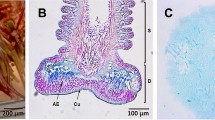Abstract.
Diatoms are unicellular microalgae encased in a siliceous cell wall, or frustule. Pennate diatoms, which possess bilateral symmetry, attach to the substratum at a slit in the frustule called the raphe. These diatoms not only adhere, but glide across surfaces whilst maintaining their attachment, secreting a sticky mucilage that forms a trail behind the gliding cells. We have raised monoclonal antibodies to the major cell surface proteoglycans of the marine raphid diatom Stauroneis decipiens Hustedt. The antibody StF.H4 binds to the cell surface, in the raphe and to adhesive trails and inhibits the ability of living diatoms to adhere to the substratum and to glide. Moreover, StF.H4 binds to a periodate-insensitive epitope on four frustule-associated proteoglycans (relative molecular masses 87, 112, and >200 kDa). Another monoclonal antibody, StF.D5, binds to a carbohydrate epitope on the same set of proteoglycans, although the antibody binds only to the outer surface of the frustule and does not inhibit cell motility and adhesion.
Similar content being viewed by others
Author information
Authors and Affiliations
Additional information
Received: 2 December 1996 / Accepted: 6 March 1997
Rights and permissions
About this article
Cite this article
Lind, J., Heimann, K., Miller, E. et al. Substratum adhesion and gliding in a diatom are mediated by extracellular proteoglycans. Planta 203, 213–221 (1997). https://doi.org/10.1007/s004250050184
Issue Date:
DOI: https://doi.org/10.1007/s004250050184




